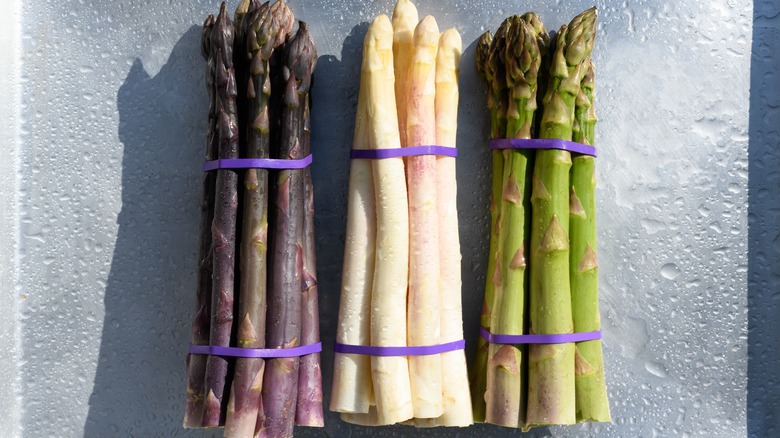Green Vs White Vs Purple Asparagus: The Difference Explained
Fibrous asparagus reeds adorn dishes like pleasant spring pastas, cheesy quiches, tangy asparagus and lemon tarts and hearty vegetarian pot pies. Oftentimes, in the United States, this asparagus is a bright, familiar spring green. However, there are other varieties of the verdant veggie. You may have come across bundles of white asparagus stems clustered together at your local farmers market, or even seen it sold in a deep amethyst hue. It's not just their colorful presentation that sets them apart. Green, white and purple asparagus also offer a range of tastes and textures.
Asparagus is a perennial vegetable, and one of the first to make an appearance at the start of spring each year. After planting, many farmers give asparagus a few years before harvesting in order to get fully matured spears. Well-cooked asparagus should remain firm and flavorful; it's important to avoid basic asparagus mistakes when preparing the spring stem and consider its color and variety.
Pick your asparagus (color)
You've probably marveled at images of asparagus growing — thin stalks poking up from the earth in peculiar-looking rows. While it might seem a little alien, this is how green asparagus grows. As the asparagus spears emerge from the dirt, they're exposed to sunlight, developing chlorophyll. This is where their color comes from. White asparagus, on the other hand, grows differently. The plant comes from the same seeds as their green siblings, however they're never given the chance to produce chlorophyll. White asparagus is intentionally weighted down with dirt or blanketed in plastic to keep it below the surface. Because they lack access to sunlight, they do not undergo photosynthesis and maintain their pale appearance.
Purple asparagus is a variety that has its roots in Italy. The planting process is akin to that of green asparagus. The spears likely get their violet hue from anthocyanin, a compound also found in red cabbage and purple cauliflower. There are a few common varieties of purple asparagus you might stumble upon at your store this spring: Purple Passion, Pacific Purple, and Erasmus.
In flavor, green is grassy and earthy, white is milder, purple is a bit sweeter. You can use green, white, and purple asparagus in the same recipes. White asparagus is significantly thicker, however, and may need more time to cook. You can also peel before preparing. For a little color-changing magic, you'll also notice that purple asparagus becomes green when heated.

